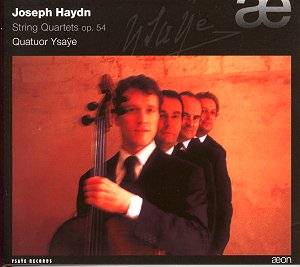The two sets of three
string quartets of Opus 54 and Opus
55, and the set of six of Opus 64, came
into being as the result of the composer's
continuing friendship with the violinist
Johann Tost.
Tost had been a prominent
member of the Esterházy orchestra,
but in 1788 he left in order to travel
abroad, until it seems he took up a
career as a merchant in Vienna. The
twelve quartets he commissioned from
Haydn around that time all encourage
a special focus on the first violin.
The composer gave special attention
to the skills of a player whom he knew
well, thereby extending towards a new
approach to a medium in which he already
excelled.
Although Haydn wrote
a great many quartets, he still managed
to give each of them a unique personality.
In these quartets the role of the first
violin, in tribute to the playing of
Johann Tost, is always worthy of special
attention. But it is by no means the
only interesting feature. For example,
did Haydn ever conceive an opening more
invigorating than that of the first
of these quartets. The rhythmic impetus
is established immediately, and the
Ysaÿe Quartet respond to the opportunity
with evident relish. The performance
has a real lift to it, and the recorded
sound is truthful and unfussy.
Of the three quartets
the second is probably the most original
in approach, because it has a finale
that begins and ends really slowly,
at tempo Adagio, while at the centre
is an intense Presto. The music poses
challenges of interpretation and characterisation,
but again both the players and the recording
engineers respond with committed ardour
to Haydnís inspired boldness.
Opus 54 No. 3 is a
subtle piece, perhaps under-stated on
first acquaintance, but the Ysaÿe
players have the measure of the music.
They capture its eloquent manner to
perfection, with a true cantabile in
the Adagio slow movement and
a terse rhythmic emphasis in the minuet.
Then the finale challenges the discipline
of the performers with a Presto
tempo, in another case of Haydnís preference
for monothematic development, everything
emanating from a single source. And
this performance is blessed with wit
and vitality, the two essential features
of the music.
Terry Barfoot
